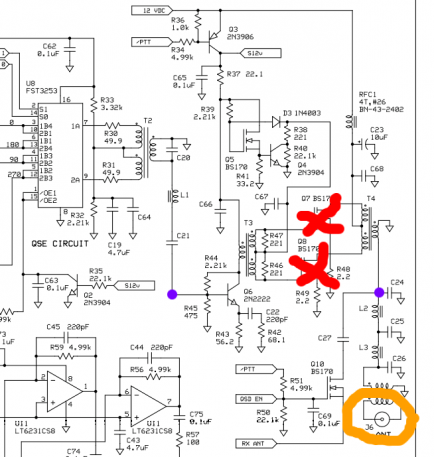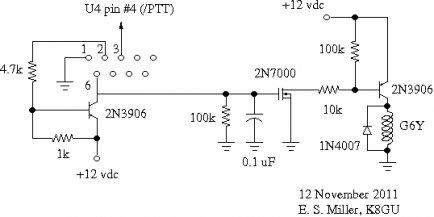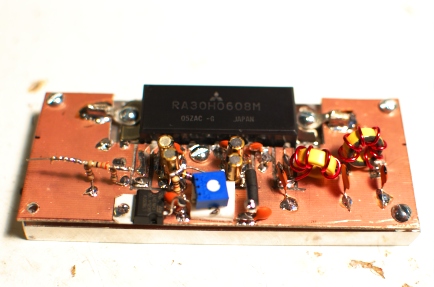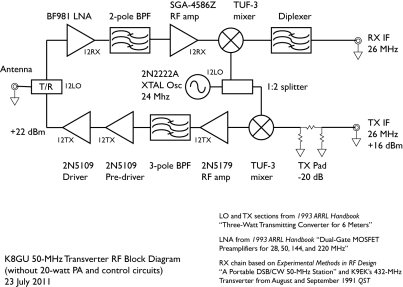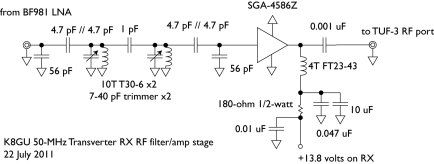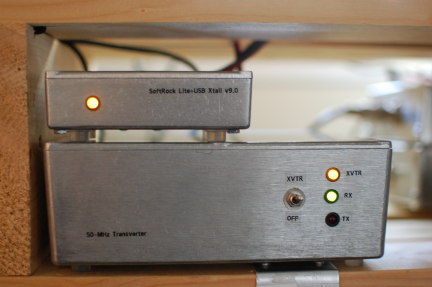Posts Tagged ‘50MHz’
 6m up and about
6m up and about
After a good few weeks without any radio fun I hooked up my semi-homebrew 2 ele beam and had a good couple of QSO’s with CT1EAV and CT1EEB on 6m. There were a good few station out this evening and I’m glad this brief outing has proven that the flimsy beam works.
 Lightweight 50Mhz Yagi
Lightweight 50Mhz Yagi
Building antennas seems to be getting to be a bit of a habit for me. This time I’ve bought a kit, for evaluation purposes. No really it is.
I was trying to think of a project that I could use at MX0WRC (Workington and district amateur radio club) to help give some direction to some of the members who may never have built anything other than the kit they built for their intermediate licence. So, as I’ve been roped in to give a talk on my portable set up, which consists of what I thought were low cost antennas I thought I’d found the right direction.
Low cost is not what I came across when researching simple antennas. It seemed that I was way off the mark for commercial offerings until I found a company in Germany called Nuxcom.  They supply what look like simple yagi kits at realistic prices. By which I mean the cost of the materials isn’t prohibitive (For example from a raw material supplier 25mm box section can be bought for as little as £6-8 for a 1m length, enough for a 3 element 2m yagi and round tube for similar cost – and this isn’t cheap Chinese metal this is western European fully traceable materials! Don’t even get me started on the price of pipe clamps)
They supply what look like simple yagi kits at realistic prices. By which I mean the cost of the materials isn’t prohibitive (For example from a raw material supplier 25mm box section can be bought for as little as £6-8 for a 1m length, enough for a 3 element 2m yagi and round tube for similar cost – and this isn’t cheap Chinese metal this is western European fully traceable materials! Don’t even get me started on the price of pipe clamps)
So, to placate my ever growing concern that prices are rising higher than a bankers bonuses, without any real justification I ordered one of the larger kits from Nuxcom, a 2 element lightweight 6m yagi. Purchasing was a bit drawn out as I placed an order and the ‘quote’ was returned with shipping costs added in a few hours later. But at £35 I was prepared to take a gamble, even is a third of the cost was shipping.
I’m expecting the kit before the weekend and I’ll do a little write up when it arrives. On the face of it the kit looks fairly simple in design without any bells and whistles, just what we need to add to the J pole, vertical and dipole designs that I plan on demonstrating.
What I’m really hoping for is a good value, simple lightweight antenna than doesn’t cost the earth so that the club members can learn and experiment without breaking the bank. More later.
 Portable 50Mhz antenna
Portable 50Mhz antenna
One of the enduring aspects of amateur radio is the emphasis on ‘experimentation’ and ‘homebrew’. To many people this means designing innovative circuits for their own transceivers, amps or whatever floats their boat. My area of interest is in collecting either bent wire, off cuts of cable and odd shaped plastic parts scavenged from just about any skip or rubbish bin I can find. Some people like to call this antenna experimentation. My XYL likes to call it ‘That junk in the garage’. I like to call it my continued education. Below is a teaser!

The latest in my armoury of ‘stuff I’ve done’ will never help anyone chase DX or bust a pile up for a little activated square or something else. But it will give me another band to work with when I’m away from home, either on top of a summit, at the mother in laws or operating portable in the summer Es season (I say summer because the top of St Bees head isn’t very welcoming in the winter as I found out whilst operating GB4LBC).
My take on the 5/8 wave 6m vertical originally published by the UKSMG by Mike, G3JVL took a little over a weekend and was made relatively cheaply from scrounged resources. I enjoyed the job so much I’ve added a little project page here which I hope you enjoy. Feel free to try it out yourself and improve on the design path I took, let me know how you got on with the manufacturing of what should be a nice project (that can also be cheap if you’re scrounging skills are up to scratch)
 Weekend 50Mhz vertical antenna
Weekend 50Mhz vertical antenna
One of the enduring aspects of amateur radio is the emphasis on ‘experimentation’ and ‘homebrew’. To many people this means designing innovative circuits for their own transceivers, amps or whatever floats their boat.
My area of interest is in collecting either bent wire, off cuts of cable and odd shaped plastic parts scavenged from just about any skip or rubbish bin I can find. Some people like to call this antenna experimentation. My XYL likes to call it ‘That junk in the garage’. I like to call it my continued education. Below is a teaser!

The latest in my armoury of ‘stuff I’ve done’ will never help anyone chase DX or bust a pile up for a little activated square or something else. But it will give me another band to work with when I’m away from home, either on top of a summit, at the mother in laws or operating portable in the summer Es season (I say summer because the top of St Bees head isn’t very welcoming in the winter as I found out whilst operating GB4LBC).
My take on the 5/8 wave 6m vertical originally published by the UKSMG by Mike, G3JVL took a little over a weekend and was made relatively cheaply from scrounged resources. I enjoyed the job so much I’ve added a little project page here which I hope you enjoy.
Feel free to try it out yourself and improve on the design path I took, let me know how you got on with the manufacturing of what should be a nice project (that can also be cheap if you’re scrounging skills are up to scratch)
 SoftRock Ensemble RXTX IF modification
SoftRock Ensemble RXTX IF modification
This is a pretty simple modification that converts a SoftRock Ensemble RXTX SDR RF interface board from “common-IF” (RX and TX share the same antenna port) to “split-IF” (RX and TX have separate ports). Split-IF is the standard for high-performance transverters on the 50-, (70-), 144-, 222-, and 432-MHz amateur bands.
So, I had a look at the RXTX schematics (here, here, and here) and considered the following options for where to break the RX and TX portions of radio:
The purple dots were the first option. Unfortunately, these locations on the actual printed circuit board were not easily accessible to miniature coax and this process would involve significant surgery to perform and restore the modification. The second alternative I considered was the red Xs…jumpering over the BS170 PA transistors. By this time, I was looking for a way to avoid butchering the original circuit too much. So, I elected for option three, which was to install a second T/R switch at the antenna jack (golden circle). This had at least two advantages, the first of which was being minimally invasive. The big advantage, though, is that the radio could be operated at its design output and run through a fixed or step attenuator on the TX side to the transverter. This meant that I would be assured of having a reasonably clean signal to work with if I configured the radio correctly. It also meant that I could operate the radio as designed if I simply disabled the the second T/R switch and connected the antenna to the default port.
So, here is the modification that I came up with using parts I had in my junk box. KB9YIG ships the Ensemble RXTX with a couple of spare BS170 FETs that can be used in place of the 2N7000. I just had a lot of 2N7000s and thought I’d save the BS170s in case I ever burnt one in the RXTX.
The interface to the transverter is through a DB9 connector. PTT for this transverter is +12 volts (as done with the TS-930S) on pin 6. Pin 1 is ground. Pins 2 and 3 are shorted together in the transverter cable connector to enable the modification in the SoftRock. The right portion of the schematic with the relay driver and Omron G6Y relay is based on the T/R switch from W1GHZ’s “Multiband Transverters for the Rover” that I decided not use on the microwaves when I found a cheap source of SMA coaxial relays. An I2C decoder would be great to put band data on the other pins to select a transverter (or transverter cascade for the microwaves).
The whole mess works great from a switching standpoint. When I key the PTT on Rocky or PowerSDR, it switches the TX line and keys the transverter. I’m a little ambivalent about the quality of transmitted signal that’s actually coming out. I think it’s good enough if you live in a sparsely-populated area, but I have a lot of VHF neighbors that I’d rather not upset. So, I need to do some more testing on this—a lot of it is getting the RXTX and PowerSDR configured correctly. It appears that the I/Q channels are flipped on my sound card (Audigy 2 ZS) between transmit and receive. I don’t know if that’s a wiring error in my breakout box or whether it’s normal. Spectra to come at some point…
 Improving 50-MHz Transmit Capability
Improving 50-MHz Transmit Capability
Over the past week in the evenings, I’ve managed to cobble a little PA together for the 50-MHz transverter. It’s a near-clone of the PA in the Elecraft XV50 using the Mitsubishi RA30H0608M. Last night, I got it all hooked up and installed in the cabinet. It broke into oscillation when keyed on CW.
The oscillation was about 50.040 MHz. I reasoned that it might be the PA output coupling into the nearby TX RF bandpass filters which are followed by 12 dB of gain before returning to the PA. So, tonight, I added a litle shield between the BPF and the PA board. That seemed to clear things up and I got about 10 watts out. There is a 6-dB pad between the last driver stage and the PA, so I should be able to get it up to about 18-20 watts. But, the first goal will be to check the linearity on SSB.
In other transmit capability news, some boxes and heatsinks arrived for the W6PQL PAs for 903 and 1296 this afternoon.
 Improving 50-MHz Receive Capability
Improving 50-MHz Receive Capability
As I mentioned previously, the receive capability in my 50-MHz transverter seemed to be a little bit anemic. So, I decided to add a little bit of gain. Looking at the block diagram for the transverter (shown below in updated form—jumper across the SGA-4586Z to understand what the circuit looked like initially—by the way, full-sized PDF versions of all of my notes and schematics will eventually be available here), I reasoned that I had the following losses and gains: +10 dB for the LNA (this might be as much as +15 dB, but 10 seems more realistic, if not generous), -3 dB for the bandpass filter, -7 dB for the mixer conversion loss, and -3 dB in the diplexer, leaving me with -3 dB overall conversion gain.
So, I endeavored to find some more gain in the form of a MMIC (which is really what all gain blocks in this transverter would be if I were to do it again). I have a nice (but dwindling) supply of SGA-4586Z’s that produce about 20 dB gain with a 1-dB compression point around 16 dBm, which is probably a good part for this location. The idea is to overcome the losses in following stages with robust gain in earlier stages (in order to keep system NF low). So, I ripped out the existing two-pole BPF and replaced it with this:
I was relatively satisfied that I had everything working with the cover of the transverter off to peak the BPF on the W3APL beacon. So, I replaced the cover and surprise! To borrow a poetic description of RF circuit doom from N3UM, the MMIC “amplifier burst into song.” Bursting into song is a bit of a charitable description for something that sounded more like S9 power line noise in the IF receiver. I did not actually know that it was the MMIC oscillating at first, but I started wiggling cables and finally found that if I touched the 12RX (+13.8 volts on RX) line, the problem disappeared. So, I added the 0.01-uF bypass capacitor to ground on the supply side of 180-ohm bias resistor and the problem was solved.
With the completion of the HF SoftRock with Si570 LO, I now have a tunable IF to play with the transverter. We had a nice opening to the Southeast and Gulf this morning and I even heard my first DX with the transverter and SoftRock combination—CO2WF. With the appropriate software, I can configure a the SoftRock as a panadapter with the TS-930S as the transmitter. More on this in the future. Best of friends:
The real next step in making the transverter useful is building a 20-watt PA stage. This should be good for driving a Mirage or TE Systems brick or even something bigger like a 3CX800 or 50-volt solid-state amp…
